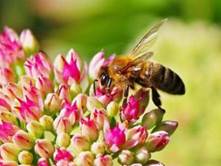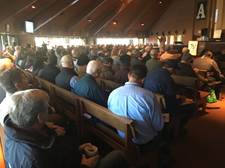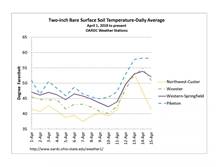Good afternoon,
Farmers have been busy planting the past three weeks with a few moderate rains to break things up. This year planting was delayed by a couple weeks due to cool and wet conditions. Because of that, the activities such as spraying fields with herbicides, applying fertilizer and tillage activities were not completely done by the usual date of the beginning of May. Most farmers only began working in the fields by that time this year. Planting progress for both corn and soybeans jumped ahead of the five-year average following a delayed start to the planting season. High temperatures with moist soil conditions also helped to promote corn emergence. Winter wheat has started to head and alfalfa will soon be cut. For more information about Ohio Crop Weather and planting season progress, see the attached USDA report. Most of the corn has been planted in Hardin County, however soybeans are still being planted in several area fields. Because of this activity along with other field activity, keep an eye out for farm machinery on the roads. I have attached an article written by Ed Lentz, OSU Extension-Hancock County that discusses farm machinery safety on the roads that you may want to read to bring yourself up to date with guidelines for transporting agricultural equipment.
Farm Machinery Road Safety News Release
If you are a beef cattle producer, you may be interested in checking out the Beef Quality Assurance training flyer for an program being held June 9 in Lexington. This event will cover proper ear tagging, tattooing and recordkeeping for purebred cattle. The Southeastern Ohio Hay Day has been planned for June 21 at the Eastern Research Station in Caldwell. See the attached flyer for registration details about this field day, which will offer demonstrations of hay harvesting equipment, tradeshow exhibits, educational presentations, dinner, and door prizes. Lady Landowners Leaving a Legacy is an interactive workshop series that provides women landowners with the confidence, skills, and resources necessary to interact with tenants and ensure the integrity of their land is preserved for future generations. See the attached flyer for more information about this series which begins June 14 in Urbana. I have also attached a flyer about a Dairy Educational Tour scheduled for June 16 in Mt. Gilead if you are interested in learning more about this industry.
Southeastern Ohio Hay Day Flyer
Upcoming local events include a Master Gardener Volunteers meeting tonight starting at 7:00 pm at Harco Industries. Dairy Beef Feeder tagging, vaccination, and weigh-in will be held Saturday, May 26 from 8:00-10:30 am at the Hardin County Fairgrounds. For more specific Information, go to https://hardin.osu.edu/news/dairy-beef-feeder-possession-deadlineregistration-due-extension-office. If you have Beef Feeders for this year’s Hardin County Fair, you will want to read about the rules at https://hardin.osu.edu/news/beef-feeder-registration. The rules for Hardin County Fair Rabbits can be found at https://hardin.osu.edu/news/rabbit-registration-due-june-1st. If you have further questions, call the Extension office and ask for Amanda Raines or Mark Light. Other than that, you may want to read the agronomy articles that I have posted below as you get ready to mow hay, spray weeds, or sidedress corn.
Mark
Warm Weather Continues…High Rainfall Variability – Jim Noel
Above normal temperatures will continue for the rest of May. Unlike temperatures, rainfall will be very inconsistent with a tendency to be wetter than normal. Some areas of Ohio will receive flooding rain while other areas will struggle to receive an inch or perhaps less than a half inch of rain for the rest of the month. Uncertainty is high for where the flooding rains will occur and where the driest areas are. Runoff will also be highly uncertain the rest of May. If you would like to read more about the weather, go to https://agcrops.osu.edu/newsletter/corn-newsletter/2018-13/warm-weather-continueshigh-rainfall-variability.
Corn, Soybean, and Alfalfa Yield Responses to Micronutrient Fertilization in Ohio – Steve Culman, Anthony Fulford, Laura Lindsey, Douglas Alt
Ohio farmers often wonder if micronutrient fertilization will increase grain yields. A recent study exhaustively compiled the last 40 years of Ohio State University micronutrient fertilizer trials in corn, soybean and alfalfa. A total of 194 trials (randomized and replicated) were found across 17 Ohio counties. In general, micronutrient fertilization rarely resulted in a statistically significant yield response. Manganese (Mn) fertilization or a blend of Mn with other micronutrients increased soybean yield in 9 out of 144 trials. Boron fertilization had no effect on corn grain yield in 8 out of 9 trials and actually decreased yield in one trial. Micronutrients had effect on alfalfa yields in 17 total trials. Go to https://agcrops.osu.edu/newsletter/corn-newsletter/2018-12/corn-soybean-and-alfalfa-yield-responses-micronutrient to read more about micronutrient fertilization efficacy in Ohio.
Be Mindful of Honeybees and Other Pollinators During Planting – Reed Johnson, Kelley Tilmon, Andy Michel
The winter of 2017-2018 is destined to go down in Ohio beekeeping history as one of the worst on record. In October, the OSU honey bee lab had 50 living colonies, but by the beginning of April, we were down to just 5 survivors. While some of these honey bee colonies died as a result of the exceptionally long, cold winter, more than half of our losses occurred before the first snow fell in November 2017. In talking with other beekeepers around the state it has become clear that 90% losses were typical for many beekeepers this year. To finish reading this article, click on https://agcrops.osu.edu/newsletter/corn-newsletter/2018-12/be-mindful-honeybees-and-other-pollinators-during-planting.
2018 Small Grains Field Day – Rory Lewandowski
Plan now to attend the 2018 Small Grains Field Day on June 12. The event will begin with registration and sign in at 9:30 am at the OARC Schaffter farm located at 3240 Oil City Road, Wooster OH. The cost is $25 per person when registered by June 4. Beginning June 5, registration will be $35 per person. Lunch is included in the registration fee. Commercial and private pesticide applicator credits as well as Certified Crop Advisor (CCA) credits are available to field day participants. Go tohttps://agcrops.osu.edu/newsletter/corn-newsletter/2018-11/2018-small-grains-field-day to find out more about this year’s Small Grains Field Day in Wooster.
Chance to view Ohio’s 2018 Conservation Tillage and Technology Conference video sessions – Sarah Noggle
For those of you who did not attend the 2018 Conservation Tillage and Technology Conference in Ada, Ohio in March, or you want to learn from concurrent sessions you missed, here is another chance. Sixty-six recorded video presentations are available at https://fabe.osu.edu/CTCon/ctc-2018-archive. Topics from the conference included: regenerative agriculture, climate change, healthy soil, water quality, research reporting of data, cover crops, federal policy, and nutrient management. Plan now to attend in 2019 on March 5-6.
Mark A. Badertscher
Agriculture and Natural Resources Educator
OSU Extension Hardin County
1021 W. Lima Street, Suite 103, Kenton, OH 43326
419-674-2297 Office











